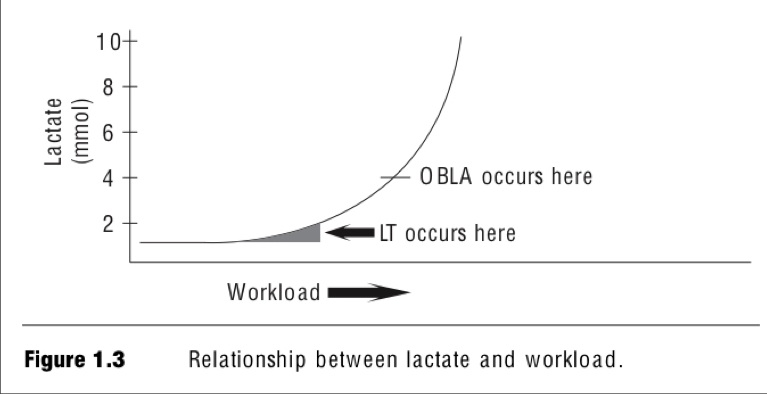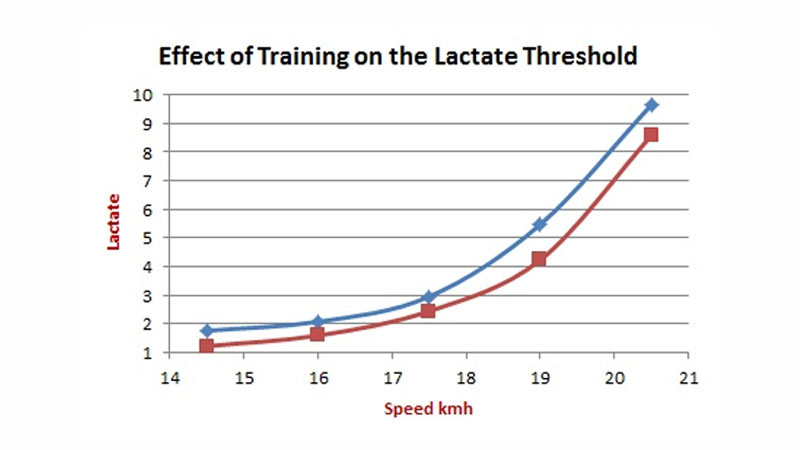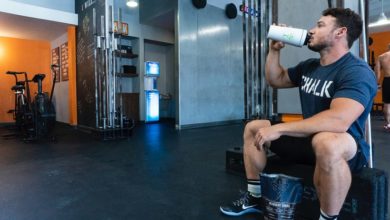
Lactic acid training drills are downright horrible. Cramps, pain, soreness, fatigue, even nausea. But they’ll also build some beautiful gains too if you’re brave enough to roll up your sleeves and get involved.
The intense burning of lactic acid is unmistakable.
High-intensity drills that increase lactate in your blood are also great for improving long-term athletic performance, stamina and recovery.
In this guide we cover everything you need to know about lactic acid training drills.
Whether you’re a cardio lover or you prefer to get jacked with strength training, we’ll cover everything you need to know about lactate threshold, lactic acid training drills and how to use high-intensity training to get leaner, stronger and jacked…
Article Summary – break it down for me
- Lactic acid is used by the body to generate ATP – the energy currency used by your cells.
- As exercise intensity increases, lactic acid is produced to buffer muscle acidity and reduce fatigue.
- You can use either strength training or cardio lactic acid training drills in your program.
- Training in and above your lactate threshold improves fitness, conditioning, fat loss and even muscle growth.
Energy Systems and Athletic Performance
The only reason you’re sat here right now in your snap back cap, stringer vest and chugging on a protein shake is because you have one wonderful talent…
Nope, not your ability to fit your fist in your mouth or bust out 50 two-finger push-ups. It’s because you can convert the energy in food into the only currency your cells can use – adenosine triphosphate (ATP).
Your body converts carbs, fats and proteins into ATP. This is achieved via 2 distinct metabolic pathways:
- Aerobic – by using oxygen to convert food energy to ATP
- Anaerobic – Same result, but without oxygen
You can only store a small amount of ATP in your body – around 100g or so if you’re an average weight dude.
That’s enough for only 3-4 seconds of all-out intensity. If your body didn’t have a way of making more ATP you’d die. Plain and simple.
Bro Fact: Rigor mortis (when your body goes rigid for a period of time after death) occurs because a lack of ATP doesn’t allow your muscles to relax.
Energy systems and their link to ATP production
The simplest, easiest way for your body to convert food into ATP is aerobically. The presence of oxygen allows you to generate more ATP than you would anaerobically.
It’s a slow process, but because you don’t need to generate ATP particularly fast when you’re at rest, it’s all good.
By eating and breathing (your favorite hobbies no doubt) you can produce an infinite amount of energy. And the only by-products you accumulate are carbon dioxide and water vapor (which you breathe out), as well as heat.
The problem is though, when oxygen is involved, the time it takes to make ATP is lengthy.
When you start exercising, the amount of energy you need often outweighs the amount you can generate in the presence of oxygen.
Your body has a solution though.
Ditch that slow ass oxygen and make ATP without it. You can’t make as much as you would aerobically, but it’s a faster process.
You can do this using an energy system called the creatine phosphate system. This energy system gives you ATP very quickly during high-intensity exercise. But after 10 or so seconds you use up your stored creatine levels and can’t maintain that intensity any longer.
And that’s where anaerobic glycolysis comes in.

When you generate ATP using anaerobic glycolysis, you begin to accumulate by-products.
Without oxygen slowing you down you can make ATP at a faster rate, helping you exercise at a higher intensity.
But there’s one catch!
By-products.
At high-intensity, you quickly run out of creatine. But before your body forces you to slow down too much it kicks in its back up anaerobic energy system called anaerobic glycolysis – often referred to as the ‘lactic acid energy system’.
Although it can’t synthesize ATP as fast as your creatine phosphate system, anaerobic glycolysis is still able to provide enough fuel for you to work.
It does this by following a few steps in which only glycogen is broken down::
- Glycogen is converted to glucose by a series of enzymes and rate step limiters
- 2 molecules of ATP are needed for this process, but 4 are generated, meaning a net gain of 2 ATP molecules for energy.
- Anaerobic glycolysis results in the accumulation of a chemical called pyruvate. It also builds up levels of hydrogen which is extremely acidic.
Because there’s no oxygen involved in anaerobic glycolysis, your body can’t break down pyruvate or stop the accumulation of hydrogen.
It has to come up with another plan…
Lactate threshold and onset of blood lactate accumulation
As you can see from the graph below, when you’re using your aerobic energy system at rest, you don’t accumulate excess hydrogen or lactic acid.
Your body finds it easy to nullify it with oxygen.
As the intensity of physical activity increases, you begin to rely on anaerobic glycolysis more and more to provide energy faster. Naturally, as the intensity of exercise rises, so does lactate concentration.
Lactate threshold (LT) is the point where lactate rises from baseline to 1mmol.L in your blood. This is still a comfortable amount to maintain and won’t have any severe or dramatic effects on exercise. But it will lead to fatigue eventually. LT also signifies an increase in glycogen use for fuel, as anaerobic glycolysis becomes more and more important.
If you choose to carry on ramping up the intensity of your workout, lactate will continue to spike. Eventually, you’ll reach a point where lactate accumulation far outweighs the amount you can flush out.
This is referred to as the onset of blood lactate accumulation (OBLA) and occurs at 4 mmol.L.
At this intensity, you’ll fatigue fast.
OBLA is sometimes called maximal aerobic speed (MAS) as it signifies the hardest you can work while still using at least some energy from your aerobic system.
[infobox]Key Point: the harder you work, the more lactate you produce.
[/infobox]
Lactic Acid Isn’t The Bad Guy
Before we move onto lactic acid training drills, you need to know this…
That goddamn awful burning feeling you get in your muscles when you’re pushing through a tough workout isn’t caused by lactic acid.
It’s the accumulation of hydrogen causing fatigue, soreness and pain.
Lactic acid is your best friend.
It acts as a buffer, reducing acidity in your muscles. And it can also be converted back into glycogen so you can make more ATP.
But it’s only a temporary measure.
At high intensity, the rate at which you can convert lactic acid back into ATP is much slower than the rate at which hydrogen increases.
After 2-3 minutes of hard, high intensity exercise, the acidity in your muscles will get to a point where you can’t bear it anymore – cramps, nausea, soreness, weakness won’t be far behind.
You can only fight muscle acidity so long before you have to slow down, let your aerobic energy system kick back in and neutralize hydrogen build up.
[infobox]Key Points so far:
- The human body can only use ATP for energy. You can store around 80-100 g of it at any one time.
- Your body makes more ATP by using one of 3 energy systems – one of these is aerobic and the other two are anaerobic.
- During exercise you need more ATP – the harder the workout, the more you need.
- Anaerobic glycolysis (the lactic acid energy system) is used for high intensity exercise and can last around 2-3 minutes before exhaustion.
- Anaerobic glycolysis can only use glycogen to generate ATP.
- Because anaerobic glycolysis doesn’t use oxygen it accumulates by-products called hydrogen and pyruvate.
- Lactate is used as a ‘buffer’ to reduce acidity in the muscle. It can also be converted back to glycogen.
- It’s the change in muscle and blood pH that causes fatigue, pain, soreness, cramps and nausea. Not lactic acid.
Lactic Acid Training Drills – The Basics
It doesn’t matter if you’re an athlete, bodybuilder or weekend warrior. If you want to get fit, strong, lean or jacked, you can use lactic acid training drills to smash your goals and chisel out a physique to be proud of.
Training theory – how does lactic acid training work?
Lactic acid training forces you to accumulate lactic in your muscles. The more often you do it, the more your body learns to ‘tolerate’ it. Not only that, but it also increases your lactate threshold too.
Over time, your body learns to become more efficient at dealing with hydrogen and pyruvate. You’re essentially teaching lactate to get better at buffering blood acidity.
The ‘right shift’ of the curve
If you couldn’t improve lactic acid accumulation there’d be no room to get fitter. Every time you trained at high intensity, you’d hit fatigue at the same point.
Luckily, with the right lactic acid training drills you can teach your body to improve performance. As fitness levels increase, so does your ability to use lactate.
The blue line in the graph below is you before using any kind lactic acid training drills. The red line is after. You can see there’s a ‘right shift’ in the graph, showing that at the same relative intensity, there’s less lactic acid accumulation.
Use These Lactic Acid Training Drills for Fat Loss and Muscle Conditioning
There are multiple ways to improve your lactate threshold.
And while they all have slightly different intensities, duration and ratios; they all pretty much follow the same rules:
- You have to purposely and repeatedly accumulate lactate in your muscles
- Working at an intensity above the lactate threshold is essential to get better
Using cardio-based lactic acid training drills
Cardio is an effective approach for improving lactate threshold and tolerance. The repetitive nature of endurance exercise combined with the intensity of exercises such as sprinting or cycling creates the perfect environment for anaerobic glycolysis.
And if you’ve ever seen track cyclists’ legs, you’ll also see how effective it is for muscle growth too.
There are multiple ways you can use cardio for lactate training. Here are our favorites;
- Split 400’s – Run, row or cycle 300 meters at 95% of your max. Rest for 1 minute and then complete 100 meters at 100% of max effort. Rest for 5 minutes and repeat this for as many reps as you can.
- Tempo training – Rather than running a 10 km race pace you complete 2 x 5 km at a faster pace, with a small rest period between sets.
- OBLA training – This one is plain awful. Spend 3-5 minutes working just above OBLA (about an 8-10 in terms of difficulty). Next, reduce the intensity down to just below OBLA (around 6-10) for the same amount of time. Complete 3 or more full intervals.
Strength training – Boost fat loss and muscle build with lactate training
High-volume strength training with minimal rest periods between sets will rapidly ramp up lactic acid levels in the working muscles.
Lactic acid doesn’t only provide your body more energy. It also triggers the release of growth hormone (GH) too. And it’s this important protein-based hormone that could be the key to a leaner, more muscular physique.
The more lactate you accumulate, the more growth hormone you release.
Growth hormone benefits your body in a number of different ways:
- Initiates higher levels of fat burning
- Partitions incoming calories into muscle cells rather than fat cells
- Enhances recovery
- Directly help you build muscle mass
- Elevates epinephrine for a higher metabolic boost
- Reduces cortisol levels
- Improves insulin sensitivity
- Works with testosterone to create a more anabolic environment

When it comes to fat loss, the increase in metabolism coupled with higher rates of fat burning will soon have you looking leaner and meaner.
For muscle building, it acts as a regulator of muscle mass by elevating protein synthesis, stimulating the release of IGF-1 (another anabolic hormone), and strength.
It just depends if you can hack the intensity or not…
Using Strength Training to Improve Lactate Threshold
Here are the very best (or should that be worst) lactic acid training drills using strength training.
Get ready for single digit body fat…
Giant sets
One of the oldest and toughest workout protocols out there, giant sets uses multiple exercises to target just one muscle; elevating lactic acid levels faster than you could imagine.
The basic idea behind giant sets is to pick 4 or more exercises for one specific muscle group – it could be pectorals, biceps, quads etc.
It’s a versatile program.
For example, for biceps you could do:
- EZ bar curl
- Seated bicep curl
- Dumbbell hammer curl
- Chins
Your aim is to complete all of the exercises back-to-back with no rest in-between, performing 6-15 reps on each exercise to absolute fatigue.
You’ll need to plan your equipment in advance.
Rest too long and lactic acid levels will start to decrease. But by hammering one muscle from multiple angles you’ll spike your load volume and provide a great stimulus for muscle building.
High-intensity resistance training (HIRT)
As a full-body circuit training system, high-intensity resistance training uses compound exercises to build muscle and torch fat. As lactic acid training drills go, this is brutal.
To plan a lactate-scorching HIRT workout you need to:
- Choose between 4-6 compound exercises that target different muscle groups
- Organize a circuit duration – 10-15 minutes works well
- Choose weights between your 6-15 rep max
- Complete each exercise one after, the other. Keep going around the circuit until the timer goes off. Record your total number of reps for future reference
- Set up a second circuit with different exercises and complete that too
Research shows that HIRT elevates the mean level of post-exercise blood lactate much higher than other methods of circuit training.
You’ll also increase post-exercise energy expenditure, elevate your metabolic rate and build good-quality muscle.
Where next?
If you want to know more about muscle building workouts or fat-shredding systems, read the following articles:







